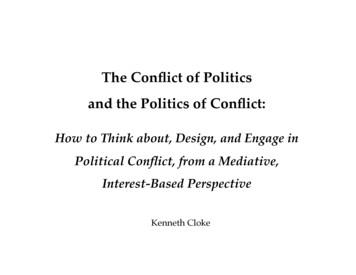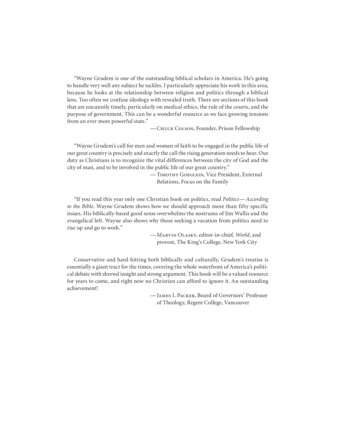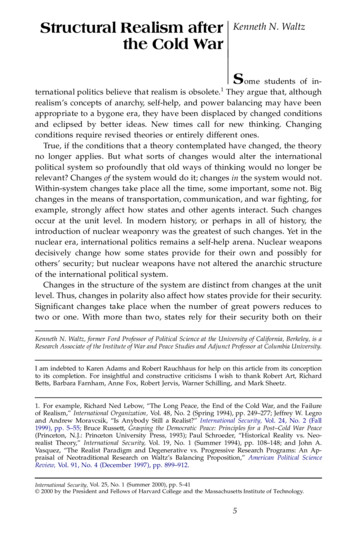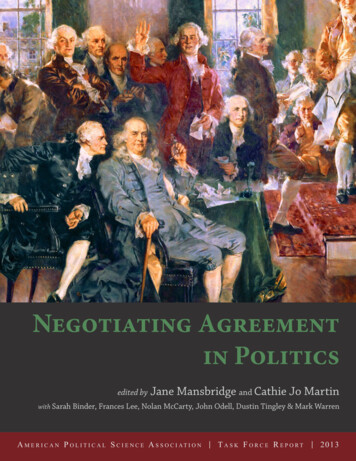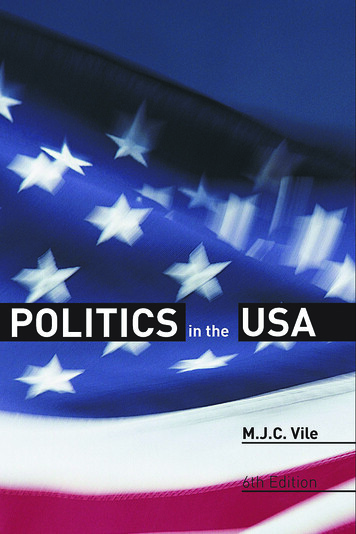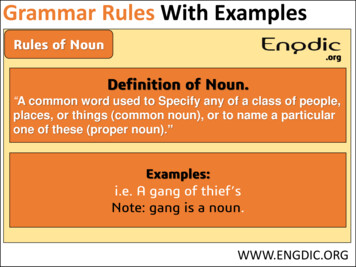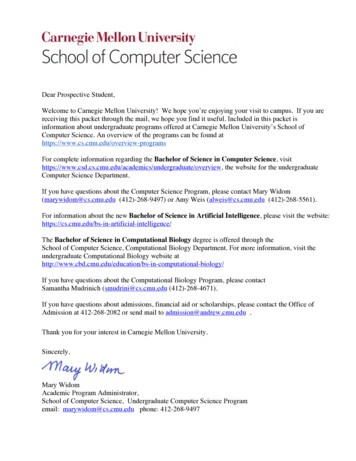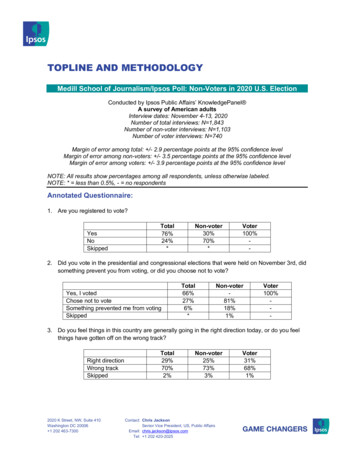
Transcription
Macquarie Matrix: Vol.1, December 2011Quis custodiet ipsos custodes – Politics and the High Court’s constitutionalreview functionR HarveyMacquarie Law School, Macquarie UniversityAbstractWhile the High Court’s constitutional review function is well-accepted in modern legaldiscourse, there has been surprisingly little analysis of what Australia’s Constitutionalframers intended for our Federal Supreme Court. First, this paper recognises that the HighCourt wields legal power that possesses significant political consequences for Australiansociety. It seeks to illustrate this proposition through a political and legal analysis of theState Banking and Bank Nationalisation cases. Secondly, it asks itself whether the High Courtwas meant to be the sole overseer of its constitutional review function, and answers thatquestion affirmatively. In doing so, it discusses the American decision of Marbury v Madison,and its significance to the Convention delegates.KeywordsHigh Court; Constitution; Banking; Chifley; Labor; Menzies; Convention Debates; Framers1
Politics and the High Court’s constitutional review functionR HarveyIntroductionA.V. Dicey, in the Appendix to his Law of the Constitution, noted that ‘the Law Courts, andespecially the Australian “Federal Supreme Court”, are the guardians of the Constitution’.(1915: 531)1 This idea was not unknown to Australia’s constitutional framers. Sir RichardBaker introduced this concept in his Manual of Reference published in 1891;2 Dr John Quickreferred to it in his Digest of Federal Constitutions published in 1896;3 and Sir Robert Garranmaintained its essentiality to federal governance in his book, The Coming Commonwealth,published in 1897.4 Indeed, a popular theme of the 1897-8 Convention debates was that ‘theConstitution will be the guardian of the State rights, and the High Court will be the guardianof the Constitution’.5 However, as one colonial commentator warned in 1898, ‘*w ho shallwatch the guardians?’6 Especially when one considers that the High Court ‘may at any timebe put in the position of having to decide a question of burning political moment’.7It is this paper’s thesis that the High Court was constitutionally intended to be thesole overseer of its constitutional review function. Part A analyses the State Banking8 and1thA.V. Dicey, Introduction to the Study of the Law of the Constitution (Macmillan and Co, 8 ed, 1915) 531.Richard Baker, A Manual of Reference to Authorities for the Use of the Members of The National AustralasianConvention (W. K. Thomas & Co, 1891) 128 (‘guardians of the public’).3John Quick, A Digest of Federal Constitutions (J. B. Young, 1896) 15, 30.4Sir Robert Garran, The Coming Commonwealth, An Australian Handbook of Federal Government (Angus &Robertson, 1897) 24, 28, 65-66, 152-4; see also Sir Robert Garran, Commentaries on the Constitution of theAustralian Commonwealth (Angus & Robertson, 1901) 725.5Official Record of the Debates of the Australasian Federal Convention, Adelaide, 30 March 1897, 336 (MrTrenwith) (‘Australian Constitutional Convention Debates’); Australian Constitutional Convention Debates,Adelaide, 30 March 1897, 272 (George Reid); Australian Constitutional Convention Debates, Adelaide, 20 April1897, 962 (Edmund Barton); Australian Constitutional Convention Debates, Adelaide, 8 September 1897, 212(Edmund Barton); Australian Constitutional Convention Debates, Melbourne, 31 January 1898, 297 (JosiahSymon); Australian Constitutional Convention Debates, Melbourne, 21 February 1898, 1260 (William McMillan);Australian Constitutional Convention Debates, Melbourne, 2 March 1898, 1724 (Josiah Symon); AustralianConstitutional Convention Debates, Melbourne, 17 March 1898, 2471 (Edmund Barton ).6Anonymous, Is Federation Our True Policy? The Politician Revealed to Himself (George Robertson and Co,1898) 137.7Australian Constitutional Convention Debates, Melbourne, 1 February 1898, 356 (Richard O'Connor).8Melbourne Corporation v Commonwealth (1947) 74 CLR 31.22
Macquarie Matrix: Vol.1, December 2011Bank Nationalisation cases9 to illustrate the political significance of this function, while PartB examines the Convention Debates to consider whether Australia’s constitutional framersintended it to shape the very course of Australia’s political development.As a preliminary matter, it is recognised that there is no agreed definition of ‘politicaldevelopment’ amongst its theorists. While the earliest works of political scientists such as KarlDeutsch,10 Gabriel Almond, and Sidney Verba11 define political development as governmentalpolicies trending towards a greater protection of civil liberties and limited economic intervention,others – like Samuel Huntington12 and Aristide Zolberg13 – define political development asgovernmental policies trending towards political stability and order. By either measure, anyexamination of the High Court’s impact on Australia’s political development may be framed interms of how the High Court has shaped Commonwealth legislative policy.A. An illustration of the High Court’s impact on Australia’s political developmenti) Bank nationalisation – the context.Bank nationalisation had been a Labor party ‘Objective’ since 1921,14 but only in a climate of ‘fullemployment’, ‘pump-priming’,15 and the nationalisation of key industries,16 did the Chifley Labor9Bank of New South Wales v Commonwealth (1948) 76 CLR 1; Commonwealth v Bank of New South Wales(Banking Nationalisation Case) (1949) 79 CLR 497 (PC).10Karl W. Deutsch, ‘Social Mobilization and Political Development’ (1961) 3 American Political Science Review40.11Gabriel Almond and Sidney Verba, The Civic Culture: Political Attitudes and Democracy in Five Nations(Princeton University Press, 1963).12Samuel Huntington, Political Order in Changing Societies (Yale University Press, 1968).13Aristide Zolberg, Creating Political Order: The Party-States of West Africa (Rand McNally, 1966).14In 1905, the Labor party began to summarise its principles in an ‘Objective’ and, by the 1921 BrisbaneConference, it read: ‘METHODS. Socialisation of Industry by:.(c) The nationalisation of banking and all principalindustries’: Lloyd Ross, ‘Socialism and Australian Labour: Facts, Fiction and Future’ (1950) 22(1) The AustralianQuarterly 21, 23.15‘Pump-priming’ refers to the policy of economic stimulation through, most typically, increased governmentspending: see Selwyn Cornish, Full Employment in Australia: The Genesis of White Paper (Research Paper onEconomic History, No 1, Australian National University, 1981) 22 as cited in Donald Markwell, Keynes andAustralia (A paper presented at a seminar at the Reserve Bank of Australia, 18 September 1985) 51.16Bruce O’Meagher (ed), The Socialist Objective: Labor and Socialism (Hale and Iremonger, 1983) 7; Seegenerally L.F Crisp, The Australian Federal Labour Party, 1905-51 (Longmans, 1955) 277.3
Politics and the High Court’s constitutional review functionR Harveygovernment venture to pass an Act like the Banking Act 1945 (Cth).17 Section 8 of that Actsought to secure: a) ‘the stability of the currency of Australia’; b) ‘the maintenance of fullemployment in Australia’; and c) ‘the economic prosperity and welfare of the people of Australia’,through monetary and banking policy. These goals were in keeping with recommendations madeby the Royal Commission on Monetary and Banking Systems in 1937; it supported ‘a system ofcentral banking in which trading banks and other financial institutions are integral parts of thesystem, with a central bank which regulates the volume of credit and currency’.18Further, the government recognised that since it was ‘in the interest of any *private bank,influenced by considerations of profit and liquidity, to expand or contract credit’ at any time, thesystem required ‘some limitation’ on that activity.19 This limitation found its way into the Act as s 8:‘*e xcept with the consent in writing of the Treasurer, a bank shall not conduct any bankingbusiness for a State or for any authority of a State, including a local governing authority’.ii) The State Banking case.The validity of the Banking Act 1945 (Cth) was challenged in the High Court by the Melbourne CityCouncil.20 Barwick KC, as he then was, argued during the course of the plaintiff’s oral submissionsthat s 48 was either: i) not legislation with respect to banking; ii) invalid for being legislation with17The ‘Bill for an Act to regulate Banking’ itself appeared to have little issue getting through both Houses:Commonwealth, Parliamentary Debates, House of Representatives, 9 March 1945, 25 (First Reading);Commonwealth, Parliamentary Debates, House of Representatives, 21 June 1945, 151 (Second Reading);Commonwealth, Parliamentary Debates, House of Representatives, 22 June 1945, 151; Commonwealth,Parliamentary Debates, House of Representatives, 26 June 1945, 157; Commonwealth, Parliamentary Debates,House of Representatives, 27 June 1945, 159; Commonwealth, Parliamentary Debates, House ofRepresentatives, 28 June 1945, 163; Commonwealth, Parliamentary Debates, House of Representatives, 29June 1945, 167; Commonwealth, Parliamentary Debates, House of Representatives, 25 July 1945, 197.18Commonwealth, Royal Commission Appointed to Inquire into the Monetary and Banking Systems at Presentin Operation in Australia (Government Printer, 1937) s. 166; see generally D.B. Copland, ‘Some problems inAustralian banking’ (1937) 47(188) The Economic Journal 686.19Commonwealth, Royal Commission Appointed to Inquire into the Monetary and Banking Systems at Presentin Operation in Australia (Government Printer, 1937) s. 532; see also Melbourne Corporation v Commonwealth(1947) 74 CLR 31, 77 (Dixon J).20C.B. Schedvin notes that the members of the Council and the banks were intimately associated: C.B.Schedvin, In Reserve: Central Banking in Australia (Allen & Unwin, 1992) 75.4
Macquarie Matrix: Vol.1, December 2011respect to State Banking;21 or iii) discriminated against an essential State Government activity’ –the ‘custody, control and disposition of government funds’.22When the Court finally handed down its decision, a 5:1 majority ruled that s 48 was invalidon the basis that the Commonwealth’s legislative power may not be used to discriminate againstState governments by placing special ‘burdens’ or ‘disabilities’ upon them.23 This decision also hada significant political impact, not just because the High Court invalidated s 48, but because itsjustification was framed in the language of ‘disabilities’, ‘burdens’, ‘hindrances’ and ‘the efficientworking of the business of government’.24The politics of the decision seemed clear. Every member of the majority spoke critically ofthe measures. Latham CJ, for instance, said that it is ‘essential that a Government should have thepower of borrowing money and of providing for the custody and expenditure of loan moneys’.25Similarly, Rich J argued for a protection of the ‘the power freely to use the facilities providedby banks, under modern conditions’.26 Dixon27 and Williams JJ,28 in separate judgments,invalidated s 48 for effectively locking the States out of the private credit market, and Starke J wentso far as to say that any attempt ‘to curtail or interfere with the management of [staterevenues and funds interferes with their constitutional power’.2921Commonwealth Constitution s 51(xiii).Melbourne Corporation v Commonwealth (1947) 74 CLR 31, 34-5.23Ibid 62 (Latham CJ), 67 (Rich J), 76 (Starke J), 85 (Dixon J).24Ibid 67 (Rich J) (‘the power freely to use the facilities provided by banks, under modern conditions, must beregarded as essential to the efficient working of the business of government, and that power cannot beimpaired’).25Ibid 53 (Latham CJ).26Ibid 67 (Rich J) (‘the power freely to use the facilities provided by banks, under modern conditions, must beregarded as essential to the efficient working of the business of government, and that power cannot beimpaired’).27Ibid 64 (Dixon J) (‘*s 48 is a law directly operating to deny to the States banking facilities open to others’).28Ibid 100 (Williams J) (‘the effect of s 48 is to deprive the States and their authorities of the use of bankingfacilities available to the general public’).29Ibid 75 (Starke J); cf 91-2 (McTiernan J).225
Politics and the High Court’s constitutional review functionR HarveyThis dictum, couched in the language of State economic sovereignty and the free-market,sent a message to the Chifley Labor government that a declaration of constitutional invalidity hada political, as well as legal, meaning.30iii) The political response to the State Banking case.The High Court’s decision was handed down on Wednesday 13 August 1947 and, ‘when most ofthe unsuspecting bankers were playing bowls or working in their gardens’,31 the Labor Caucusagreed to nationalise the banks the following Saturday. For the Chifley Labor government, the HighCourt’s decision was ‘the thin end of the wedge’,32 or as C.B. Schedvin described, ‘the first step in alegal onslaught’33 against government policy that demanded immediate action. On 27 November1947, the decision to nationalise Australia’s banks became law.The Banking Act 1947 (Cth) gave the Commonwealth sweeping powers. It provided for theCommonwealth’s compulsory acquisition34 of Australian shares in any of the private banks.35 Uponthe acquisition of those shares, the directors of that bank would cease to hold office,36 and newdirectors would be appointed by the Governor of the Commonwealth Bank.37 Those directorswere vested with full power ‘to manage, direct and control the business and affairs’ of that bank,30See, eg, Anonymous, ‘Memorandum: Upon the Decision of the Privy Council in the Case of Webb v Outtrim’,in Papers of Alfred Deakin (1804-1973) 13 http://www.nla.gov.au/apps/cdview?pi nla.ms-ms1540-15-3456 .Alfred Deakin, as then Attorney-General, recognised this political element during the passage of the JudiciaryAct 1903 (Cth): Sally Warhaft, Well May We Say: The Speeches That Made Australia (Black Inc, 2004) 142(‘although *the High Court relates to legal machinery, the purposes to be served by that machinery are but in afractional sense legal, are in the main general, and in a very particular sense, political’).31Margaret Myers, ‘The Attempted Nationalization of Banks in Australia, 1947’ (1959) 35(71) Economic Record170, 176.32Robert Crawford, ‘Supporting Banks, Liberals and the Australian Way: The Freelands and the 1949 Election’(2003) 2(3) History Australia 84.1, 84.3; one of the strongest advocates was the Fabian Society of New SouthWales: see NSW Fabian Society, The Case for Bank Nationalisation, Pamphlet No. 1. (Worker Trustees, 1947).33Carl Boris Schedvin, above n 25, 75.34Section 15 provided for the payment of fair compensation: Commonwealth v Bank of New South Wales(Banking Nationalisation Case) (1949) 79 CLR 497, 620 (Lord Porter).35Banking Act 1947 (Cth) s 13.36Banking Act 1947 (Cth) s 17.37Banking Act 1947 (Cth) s 18.6
Macquarie Matrix: Vol.1, December 2011including its disposal.38 While the Act allowed private banks to enter into agreements with theCommonwealth Bank to facilitate the transition,39 a bank’s business and assets were to becompulsorily transferred to the Commonwealth Bank if any agreement fell through.40 Finally, theTreasurer could, ‘by notice published in the Gazette and given in writing to a private bank, requirethat private bank to cease, upon a date specified in the notice, carrying on banking business inAustralia’.41 The Act, in short, gave the Commonwealth, through its agent, the CommonwealthBank, a virtual monopoly over Australian banking business.42The banks rallied in response to this legislation and, for two years, Australians ‘weresubjected to the most intense, highly organised, highly financed, and unscrupulous propagandacampaign they had ever experienced’.43 When three of the private banks, led by the Bank of NewSouth Wales, sought an injunction to restrain the Commonwealth, the conflict crystallised into,what then Associate-Professor Geoffrey Sawer described as, ‘one of the greatest political andlegal battles in Australia’s history’.44iv) The Bank Nationalisation case and the November election.The banks were successful; mostly on the basis that the Act infringed ss 92 and 51(xxxi) ofthe Constitution.45 Four Justices held that ss 13 and 14 – the powers to acquire Australianshares in the private banks – were invalid for constituting a scheme of compulsory38Banking Act 1947 (Cth) s 19.Banking Act 1947 (Cth) s 22.40Banking Act 1947 (Cth) s 24.41Banking Act 1947 (Cth) s 46; see Commonwealth v Bank of New South Wales (Banking Nationalisation Case)(1949) 79 CLR 497, 621 (Lord Porter).42See generally Robert Menzies, ‘Socialised banking: Instrument of tyranny’ in Graeme Starr (ed) The LiberalParty of Australia: A Documentary History (Heinemann, 1980) 137.43Robin Gollan, Revolutionaries and Reformists (Allen and Unwin: Sydney, 1975) 222. For a detailed discussionof these marketing practices see Crawford, above n 35.44A. L. May, The Battle for the Banks (Sydney University Press, 1968) 16.45Section 92 of the Constitution provides: ‘On the imposition of uniform duties of customs, trade, commerce,and intercourse among the States, whether by means of internal carriage or ocean navigation, shall beabsolutely free’. Section 51(xxxi) provides: ‘The acquisition of property on just terms from any State or personfor any purpose in respect of which the Parliament has power to make laws’.397
Politics and the High Court’s constitutional review functionR Harveyacquisition without compensation on just terms.46 A similar conclusion was reached inrelation to s 2447 as well as those provisions concerning business acquisition and boardmanagement.48 Further, the prohibition on private banking business in s 46 of the Act wasstruck down by four Justices as an infringement of s 92 of the Constitution.49Not unlike the ideology of the State Banking judgments, their Honours adopted an‘individual rights’ approach – described by Blackshield and Williams as ‘a high point’ in thejurisprudence of s 9250 – that was sympathetic to private enterprise and an inter-statemarket ‘free of governmental prohibitions, restrictions and burdens whether they belegislative or executive in character’.51Dixon J, for example, noted that ‘a large part of the business of banking’ dependedon ‘trade, commerce and intercourse among the States’.52 That business included:(a) the constant inter-State transmission of funds and transfer of credit;(b) the constant business communication and intercourse among the States;(c) the regular use of instruments of credit in inter-State transactions;(d) the integration of inter-State banking transactions with banking business to form a systemspreading over the Commonwealth without regard to State lines; and(e) commercial dealings between inter-State traders in goods.5346Bank of New South Wales v Commonwealth (1948) 76 CLR 1, 254, 259, 264, 267 (Rich and Williams JJ) 317(Starke J) 329-30, 344, 352 (Dixon J).47Ibid 219 (Latham CJ) 259 (Rich and Williams JJ) 320 (Starke J) 329, 375 (Dixon J).48Ibid 216-18 (Latham CJ) 319 (Starke J) 394-5(McTiernan J) 353 (Dixon J).49Ibid 291 (Rich and Williams JJ), 324-5 (Starke J); 329-30, 380-4 (Dixon J); Commonwealth v Bank of New SouthWales (Banking Nationalisation Case) (1949) 79 CLR 497 (PC).50Anthony Blackshield and George Williams, Australian Constitutional Law and Theory: Commentary andthMaterials (Federation Press, 4 ed, 2006) 1242; see also Bank of New South Wales v Commonwealth (1948) 76CLR 1, 282 (Rich and Williams J); James v Cowan (1930) 43 CLR 386, 418 (Isaacs J).51Ibid 383 (Dixon J).52Ibid .53Ibid 380.8
Macquarie Matrix: Vol.1, December 2011All of this, his Honour argued, was protected by s 92. Dixon J could not see how closing upevery bank but a government bank left inter-State banking free.54 The decision was appealedto the Privy Council in London, but their Lordships found themselves adopting the ‘languageand reasoning of Dixon J’, to which they could add nothing.55The State Banking and Bank Nationalisation cases are often cited as illustrations of thepolitically devastating impact of the High Court’s constitutional review for good reason.56 First, the‘contemporary enthusiasms’ of the Chifley Labor government were frustrated by judicialmajorities guaranteeing ‘continued private enterprise’ at the expense of ‘monopolyenterprise’.57 To adopt the phraseology of Deane J in Miller v TCN Channel Nine, s 92 wastransformed into a ‘constitutional guarantee’ of laissez-faire economics and ’smallgovernment’ politics.58 Secondly, the decisions ‘struck at the Labor Party’s roots’.59 Banknationalisation, a ‘dead issue’60 in the 1946 election, became the issue in the 1949 election.Not only did the Chifley Labor government lose office in that election, it lost its majority inthe Senate and held only 47 out of 120 seats in the Lower House. 61 This loss fuelled Labor’sgrievances with the High Court and a Constitution they had no hand in drafting.6254Ibid 388.Commonwealth v Bank of New South Wales (Banking Nationalisation Case) (1949) 79 CLR 497, 633 (PC).56See Geoff Lindell, ‘The Australian Constitution: Growth, Adaptation and Conflict - Reflections About SomeMajor Cases and Events’ (1999) 25(2) Monash University Law Review 257.57Geoffrey Sawer, Australian Federal Politics and Law 1929-1949 (Melbourne University Press, 1963) 23; seealso Peter Hanks, ‘The Political Dimension of Constitutional Adjudication’ (1987) 10 University of New SouthWales Law Journal 141, 143-5.58Miller v TCN Channel Nine (1986) 161 CLR 556, 618 (Deane J).59Brian Galligan, Politics of the High Court (UQ Press, 1987) 118; see also Frank Farrell, ‘Internationalism, andthe Australian Labour Movement’ (1985) 15 Labour/Le Travail 125, 138.60May, above n 50, 8; Crawford, above n 38, 84.2; cf to Myers who stated that ‘*m any of the points raised bythe Members [in Parliament] were depressingly similar to those of all the banking debates which had gonebefore: Myers, above n 37, 178.61Ibid 184.62Ibid; see also David Solomon, The Political Impact of the High Court (Allen & Unwin, 1992) 13; Justice RonaldSackville, ‘Law and Social Change’ (a paper presented at 6th Annual Members' Conference of theAdministrative Decisions Tribunal, 27 October 2006) 06/28.html .559
Politics and the High Court’s constitutional review functionR HarveyThis chapter in Australian constitutional history ultimately begs one to ask whether Australia’sconstitutional framers intended for the High Court to occupy such a politically significant role.B. Justifying the High Court’s impact on Australia’s political developmentOne need not look far to see that the High Court wields significant legal power through itsconstitutional mandate. As the ‘Federal Supreme Court of Australia’,63 the High Court has anextensive appellate jurisdiction that allows it to hear and determine appeals fromjudgments, decrees, orders and sentences of: any Justice or Justices exercising the originaljurisdiction of the High Court;64 any other federal court, or court exercising federaljurisdiction;65 the Supreme Court of any State;66 any other court of any State from which, atthe establishment of the Commonwealth, an appeal lies to the Queen in Council;67 and the(now defunct) Inter-State Commission, but as to questions of law only.68The High Court also has an extensive original jurisdiction in matters: arising under anytreaty;69 affecting consuls or other representatives of other countries;70 in which theCommonwealth, or a person suing or being sued on behalf of the Commonwealth, is aparty;71 between States, or between residents of different States, or between a State andthe resident of another State;72 in which a writ of mandamus or prohibition or an injunction63Commonwealth Constitution s 71.Commonwealth Constitution s 73(i); (Cth) Judiciary Act 1903 (Cth) s 34.65Commonwealth Constitution s 73(ii); (Cth) Judiciary Act 1903 (Cth) s 35(1)(b).66Commonwealth Constitution s 73(ii); Judiciary Act 1903 (Cth) s 35(1)(a). This has also been extended to anySupreme Court of a Territory: Judiciary Act 1903 (Cth) s 35AA.67Commonwealth Constitution s 73(ii).68Commonwealth Constitution s 73(iii). The Inter-State Commission was repealed by the Industry CommissionAct 1989 (Cth) (repealed) s 48(2).69Commonwealth Constitution s 75(i).70Commonwealth Constitution s 75(ii).71Commonwealth Constitution s 75(iii).72Commonwealth Constitution s 75(iv).6410
Macquarie Matrix: Vol.1, December 2011is sought against an officer of the Commonwealth or Federal Court;73 and; arising under theConstitution or involving its interpretation.74However, nowhere in the Constitution does it expressly state that the High Court hasthe power to invalidate a Commonwealth Act of Parliament.75 One must consider thedecision in Marbury v Madison76 to appreciate how it nonetheless does so.i) Whether Marbury v Madison is axiomatic.Like the State Banking and Bank Nationalisation cases, Marbury was born of political fire andbrimstone.77 That case arose out of the failure of President John Adams and John Marshall,then Secretary of State, to deliver commissions of appointment to four Federalist Justices ofthe Peace before Thomas Jefferson’s presidential inauguration. The new President refusedto recognise the outstanding commissions, and the appointees sought writs of mandamusfrom the United States Supreme Court to compel him to recognise their appointments.Marshall CJ, as he went on to become, refused to grant the appointees the relief theysought. His Honour noted that the Court’s jurisdiction to grant prerogative writs wasoriginal, not appellate; so the Judiciary Act of 1789, which purported to confer the Courtwith power to grant such writs, was unconstitutional for attempting to confer upon itoriginal jurisdiction.78 Under the American Constitution, Congress could only confer theCourt with appellate jurisdiction.73Commonwealth Constitution s 75(v).Judiciary Act 1903 (Cth) s 30(a); enacted pursuant to Commonwealth Constitution s 76(i).75For an extensive discussion of the constitutional implications see P.H. Lane, ‘Judicial Review by the HighCourt’ (1966) 5(2) Sydney Law Review 203.76(1803) 1 Cranch 137.77For a detailed discussion of the case and it surrounding political consequences see Margaret Kelly, ‘Marburyv Madison: An Analysis’ (2005) 1(2) High Court Quarterly Review 58.78Marbury v Madison (1803) 1 Cranch 137.7411
Politics and the High Court’s constitutional review functionR HarveyIn coming to these conclusions, Marshall CJ said that ‘it is a proposition too plain tobe contested, that the constitution control any legislative act repugnant to it’,79 anddescribed this right as ‘so established’, ‘original’ and ‘fundamental’. His Honour held thatAmerica’s founding fathers explicitly chose a written constitution as their ‘superiorparamount law’,80 which ‘defined’ and ‘limited’ the Legislature’s powers. Further, legislationthat was constitutionally ‘repugnant’ would not bind the courts. Most importantly, however,Marshall CJ reserved the ‘duty’ of determining constitutional repugnancy to the SupremeCourt. 81A popular theme in Australia’s constitutional jurisprudence is that the principle ofMarbury v Madison is axiomatic.82 Brian Galligan has recognised that judges have usuallytaken constitutional review for granted83 or appealed to the justificatory reasoning ofMarbury as ‘self-evident and sufficient’.84 However, while Australia’s constitutional framerswere aware of the idea that a Federal Supreme Court could determine an Act of Parliamentultra vires of the Constitution, Marbury was hardly known to them.85 This is borne out in aletter from Edmund Barton to Andrew Inglis Clark in 1898:I have to thank you further for your telegram as to the striking out of the power given to theHigh Court to deal with cases of mandamus and prohibition against Officers of theCommonwealth. None of us here had read the case mentioned by you of Marbury v Madison,79Ibid 176.Ibid 177.81Ibid 177-8.82Australian Communist Party v Commonwealth (1951) 83 CLR 1, 262 (Fullagar J); see also Sir Owen Dixon,Jesting Pilate (Law Book co, 1965) 166, 174.83See, eg, Federated Amalgamated Government Railway and Tramway Service Association v New South WalesRailway Traffic Employees Association (1906) 4 CLR 488, 490-1, 509; Baxter v Commissioners of Taxation (NSW)(1907) 4 CLR 1087, 1125.84Galligan, above n 67, 43.85Chief Justice Robert French, ‘Constitutional Review of Executive Decisions – Australia’s US Legacy’ (A paperpresented at the John Marshall Law School, 25 and 28 January 2010) 4; and, if so, apparently after Clark’stelegram: Convention debates: Australian Constitutional Convention Debates, Melbourne, 4 March 1898, 18751884.8012
Macquarie Matrix: Vol.1, December 2011or if seen it had been forgotten – it seems however to be a leading case. I have given notice torestore the words on the reconsideration of the clause.86Clark’s clause ultimately found its way back into the Constitution,87 but no expressconstitutional review function was afforded to the High Court. Nevertheless, the conventiondelegates seemed to think that a Federal Supreme Court, as the sole interpreter and‘bulwark’88 of the Constitution, simply possessed this power. This sentiment was perhapsbest captured by Isaac Isaacs, who noted at the Third Session of the 1898 debates that ‘thepower is not expressly given in the United States Constitution but undoubtedly the [UnitedStates Supreme Court exercises it’.89ii) The High Court – ‘keystone to the federal arch’.90Two discussions bear out the proposition that the framers intended for the High Court todeclare Acts of Parliament constitutionally invalid, and to oversee that power independentlyof other governmental organs.On Tuesday 1 March, Mr Gordon, of South Australia, put the following moti
business for a State or for any authority of a State, including a local governing authority [. ii) The State Banking case. The validity of the Banking Act 1945 (Cth) was challenged in the High Court by the Melbourne City Council.20 arwick K , as he then was, argued during the course of the plaintiff [s oral submissions
